Setting the
Fashion with the Patterson Girl
The Varied Career of Russell Patterson
We’re tempted to think, those of us who ponder such
matters at all, that John Held, Jr. personified the Roaring Twenties. More than
any other cartoonist in the popular memory, Held captured in his unique graphic
abstractions the fashions and fads of the collegiate jazz age. His leggy flappers
with noses in the air and hose rolled at the knee and his bell-bottomed sheiks
with their hair plastered tight to cue-ball heads personified the Younger
Generation to a nation of readers. His comic figures, shorthand caricatures in
geometric shapes with large heads and spindly bodies, were rendered in
delicate, fragile lines against which Held contrasted artfully spotted stark
blacks with striking liberality. Sophisticated and vaguely dissolute, his
short-skirted cuties were insatiable neckers, and their tuxedo-clad escorts
inveterate social bootleggers, a flask on every hip. Held’s work appeared most
regularly in Life, Judge, Liberty,
and the decade’s newest national magazine—one that appealed to all ages with
its frolicsome portraits of alleged campus life—College Humor.
Alas,
Held, identifying intimately with the frivolity of the twenties, didn’t make
the transition to the depression times that followed in the next decade, and
his cartoons disappeared from the national scene. He called it a career, took
up painting, became an excellent water-colorist, and taught art at a university
for the rest of his life. From being omnipresent in the twenties, Held went to
invisibility in the thirties. His friend Al Hirschfeld, asked why Held had
vanished so quickly and so completely, said: “Short skirts went out, long
skirts came in. John couldn’t draw long skirts so Russell Patterson took his
work away from him.”
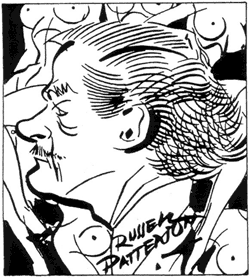
Russell Patterson was the other cartooning totem of the day. His work did as much to define the Roaring Twenties as Held’s. It was Patterson who clothed flappers in raccoon coats and unfastened galoshes, setting a fashion for the times. We don’t think of Patterson and Held as contemporaries let alone co-contrivers of the imagery of the age, but that may be because Patterson went on, beyond the twenties and that decade’s storied roar and into the staid thirties, the war-torn forties, and, even, into the long summer afternoon of the fifties. And since he outlasted the twenties, we don’t identify him with that decade as closely as we do Held.
Technically,
the work of the two cartoonists had a surface similarity: Patterson, too,
contrasted chunky solid blacks against a fine crisp penline. But Patterson’s
line was sketchier than Held’s, and its wispy looseness lent his pictures an
airy, breezy informality in comparison to Held’s studied geometry. And
Patterson’s almond-eyed girls were gorgeous. Patterson was a painter as well as
a cartoonist, and his girls were realistically illustrated rather than
expressionistically caricatured visions of femininity (if idealism can ever be
rendered realistic). Held’s girls were comedic emblems; Patterson’s statuesque
illustrations. Held’s girls were jazz age improvisations; Patterson’s,
symphonic orchestrations. Held’s flappers were all legs and knobby knees;
Patterson’s, long-stemmed and sveltely curvaceous, with torsos that, once
flat-chested went out of style, were architectural triumphs. That Patterson’s
drawings of women were imbued with structural understanding is not surprising:
he had begun his artistic career by studying architecture briefly at McGill
University in Montreal.
Patterson
had never been serious about architecture, not the kind that results in
buildings at any rate. Born in Omaha, Nebraska, on December 26, 1893, he had,
by the time college beckoned, formed the idea of becoming a magazine cover
artist. At the time, the family was living in Montreal, to which his father, a
railway lawyer, had followed the Canadian Pacific, and Patterson pere, hoping his son and heir would
become an engineer, had aimed his scion at McGill. But young Patterson had seen
a particularly seductive Collier’s cover by Joseph Leyendecker and decided, “then and there,” as he later said, to
be a cover artist.
When
he announced this decision to his father, “all hell broke loose,” Patterson
wrote. “He got red in the face, pointed at me and shouted, ‘Not with me you
won’t. If you want to be one of those fellows with smocks, a tam, baggy pants
and a big bow tie, get out! Go to Paris and live in an attic but not on my
money!’”
Ultimately,
they compromised. Patterson would go to McGill, and his father agreed to let
him study architecture. It was the closest thing to Art that young Patterson
could find that his father would consent to. But Patterson’s artistic training
was mostly catch-as-catch can.
He
didn’t finish his studies at McGill: when the family business, a hotel, was burned
to the ground, Patterson left college to get a job and contribute to the family
coffers. He worked at the Montreal Star,
taking want ads over the counter and, in his spare hours, copying the pictures
that George McManus and Harrison Fisher made. About a year later, he found a
job as a sports cartoonist at the Montreal
Weekly Standard, but, after appearing in only a single edition, he was
fired because his drawings were larger than the editor wanted. Next, he landed
at the city’s French paper, La Patrie,
where he lasted a year and drew his first comic strip, Pierrette et Pierrot.
In
about 1913 or 1914 (he couldn’t recall exactly), Patterson left Canada for
Chicago, where he did a variety of commercial jobs, including drawing interiors
for furniture ads in newspapers and magazines. His architectural career had
equipped him to draw furniture but not people. Whenever a furniture ad required
human props, “they’d have someone else put in the figures,” Patterson ruefully
reported. Quickly tiring of this affront, he enrolled in the Art Institute of
Chicago, attending for five terms at intervals between 1916 and 1919. He opened
his own studio about 1916, and somewhere along the way, he joined the Royal
Canadian Air Force to fight in World War I. He learned to fly but saw no
combat: once his artistic ability was discovered, he was put to work drawing
training aids and other materials for the service. He married his first wife,
Constance Burke, in 1918.
Patterson
was still not permitted to draw people in the ads he was doing, and he was
getting “sick and tired” of having his pictures populated by someone else. In
1920 he had a good year and thought he had enough money saved to finance six
weeks in France to learn to draw the figure. Once in Paris, he found himself
stranded. He had neglected to guarantee his return passage, and when the time
came for him to embark for the U.S., he discovered he’d have to wait for two
months.
“There
was nothing else to do but use a little of my return money daily in order to
survive,” he said.
His
survival maneuver consumed his return fare, and he wound up spending the next
year in France, moving around a lot, from one artist friend’s studio to
another’s, sometimes living for a few weeks at a time in an apartment whose
usual occupant was temporarily out-of-town. Luckily, Patterson had a brother
who was an art agent in Chicago and who found assignments for him occasionally.
During
that bohemian year, Patterson hobnobbed with such artists as Warshaski, Paul
Signac, Gilbert White, and the Pissaro brothers. He lived for a time in the apartment of Pierre Bonnard. He spent
the summer in a little hotel in Petite Andle, a small town on the Seine, two
hours from Paris. Claude Monet lived just down the road. “I painted and they
all helped me,” Patterson said. The following winter, he earned his way by
drawing castle interiors for a Chicago furniture company, a client his brother
Tom had hustled for him back home. And he went to life drawing classes.
“Paris
is cold from November to May, so whenever I had a franc, I went to the only
place I knew where I could get warm—a life class,” Patterson wrote years later.
“My favorite was close by in the Latin Quarter. It was built like a very small
theater in the round. The model’s platform was in the middle of the room with a
pot-bellied stove on it plus a chair. There was no dressing room so the model
stripped and dressed in full view. These girls were beautiful and usually made
a big thing of the strip. When special models were there, you had to make it
early to get a seat.
“The
favorite was a beautiful brunette. She liked ribbons and so did the men. Her
bra was tied with a ribbon in the back, her lace panties were tied on the
sides. A lace band around her waist had long ribbons. These she put through
loops she had on her stockings. She took her time dressing and undressing and
responded shyly to the applause. From two in the afternoon until six, the girls
went from one-minute poses to fifteen minutes. I learned to draw the figure.”
When
Patterson returned to Chicago in the fall of 1922, he continued for a while
drawing interiors for furniture companies, and he drove to California where he
arranged an exhibition of his paintings, but the trip was not a success: he
sold few paintings, and in New Mexico, he tried painting the gorgeous vistas
but found he couldn’t paint “this large country.” Driving back to Chicago, he
was haunted by the recollection of the pleasant days spent drawing nudes in
Paris. At last, inspired by the flappers he saw all around him, he began
putting fetching versions of them into his interiors. He remembered seeing
Canadian girls in raccoon coats and open galoshes, and he dressed his American
ladies likewise. He soon lost his furniture accounts, but other clients found
him. Pete Martin, editor of the a-borning College Humor magazine, came calling, and the “Patterson Girl” became a
fixture in the magazine. And the Flaming Youth of the Jazz Age started wearing
fur coats and unfastened overshoes. Sadly, little of Patterson’s original art
of this period exists: he destroyed most of it because it took up too much
space in his studio.
Patterson
brought back with him from his Parisian sojourn an understanding of pen-and-ink
artistry that was, just then, found more among European artists than among
their North American brethren. According to Armando Mendez in the introduction
to Top Hats and Flappers: The Art of
Russell Patterson, Patterson had found inspiration in the simple linear
effects achieved by such penmen as Charles Martin, George Barbier, Eduardo
Benito, Pierre Brausad, Umberto Brunelleschi, and Andre Marty. Patterson
learned that he didn’t have to paint with a pen; he could abandon the
crosshatch effects of Pyle, Gibson, and Flagg. “Fashion illustration,” Mendez
notes, “was marked by incredibly delicate watercolor and an essential
abstraction of the figure into elegant, elongated, narrow, vertical columns of
color and line, with no modeling within the figure. The faces were exaggerated
stretched elipses on long necks, and the features—inscrutable eyes and crescent
lips—a repetition of smaller ovals.” Patterson was not alone in feeling the
influence of the French stylists. Other Americans—Ralph Barton, for instance,
and theater designers like Joseph Urban and Erte, not to mention illustrators
Helen Dryden, Rene Bouche, and Carl Ericcson—took up the new mannerisms. While
Patterson never cited the French influence on his style, his work tells us all
that he neglects to mention. To their airy penmanship, he added a unique and
stunning touch—anchoring the frilly filigree of his feminine figure drawings to
huge stolid chunks of unrelieved black.
The
exposure in College Humor brought the
Patterson Girl to the attention of Bill Ziff, publisher of Ziff’s magazine, who made a proposal to the artist that would
yield one of the more intriguing tidbits of the Patterson legend. Ziff wanted
to publish Patterson drawings but instead of paying for them, he offered
advertising space. To take advantage of the free advertising, Patterson’s
brother suggested that they start a correspondence course, and “Russell
Patterson’s School of Humorous Illustration” was founded forthwith. Patterson
conjured up 20 lessons, and was soon swamped with students. One of them may
have been a Kansas City resident named Walt Disney. Years later, according to
Patterson, he met Disney, now a world-famous name in animation, and Disney
dumfounded him by saying, “Patterson—you bastard! You got me into all this!”
The
correspondence school soon proved overwhelming in its demands for time and
money (postage alone was beyond the primitive budget Patterson and his brother
had devised), so Patterson was happy to accept an offer from King Features to
come to New York and work for the Hearst newspaper there.
A
week before Christmas in 1925, Patterson arrived in the Big Apple, and the big
time wasn’t far behind. Shortly after the first of the year, he was drawing his
girls in color to adorn ads for Rolls Royce and Buick and doing color covers
for Hearst’s Sunday American,
alternating with Held and Nell Brinkley. He was making $2,000 a week and living
the high life of the big city. One day Patterson and a friend were having lunch
in the Madison Hotel diningroom when a dignified-looking older man wearing a
high collar shirt walked over to their table and stuck out his hand.
“You’re
Russell Patterson,” the man said, “and I’m Charles Dana Gibson. I’ve been
trying to meet you for months to tell you I’m crazy about those little girls of
yours.”
And
so the mantle passed from the delineator of one generation’s ideal of feminine
beauty to the maker of the next’s iconography. Patterson’s girls were to the
1920s what Gibson’s had been to the 1890s. Considered a connoisseur of feminine
embonpoint, Patterson was invited to serve on the jury for the 1927 Miss
America competition, a sentence he served until 1954. And Patterson’s girls set a standard for the illustrators and
cartoonists of the era, influencing not only their endeavors but the perception
of fashionable beauty by the public at large and women’s clothes designers,
too.
Patterson
did covers and illustrations for every major magazine of the day, including a
1931 newcomer called Ballyhoo, a sort
of outhouse version of the more sophisticated Life humor magazine Gibson was editing in its final days. Patterson
joined Ballyhoo’s editor, Norman
Anthony, in producing a musical revue called “Ballyhoo of 1932.” Patterson
designed the sets and costumes. It wasn’t his first foray into the theater—he’d
done the costumes for “The Gang’s All Here” the year before—but this earlier
enterprise flopped, and “Ballyhoo” ran for 95 performances (and introduced Bob
Hope in his first role other than chorus boy).
Patterson
did magazine and newspaper illustration throughout the decade. He did
serialized comic strips for Hearst’s The
American Home Journal, among them: Cookie (1928), Runaway Ruth (1929), Whoa Nellie (1930), Almost a Bride (1932) and Get-Your-Man
Gloria (1932). Patterson also did costume and set design, working for
various stretches in Hollywood. A dapper dresser with an elegant profile, he
even appeared in one of the movies he worked on—in “Artists and Models” in
1937, as himself. He also created a variation on his statuesque beauty—a buxom
dumb blonde in three dimensions. She was a marionette, and she and her
supporting cast appeared in various showcases in New York through the thirties
as the “Patterson Personnettes.” While producing these shows, Patterson met
Ruth Cleary, a composer, whom he married in 1938.
Patterson
expanded upon his costuming career to create women’s fashions. During World War
II, he had designed the uniform for the WAACs (Women’s Auxiliary Army Corps),
and after the War, he formed Pattikins, a company that produced clothing for
girls and teenagers. He put his set designing experience to use in creating
superclubs, theaters, hotel lobbies, even the interiors of trains. And his
engagement in the performing arts gave him the idea to turn Ellis Island into
an amusement park, and while that didn’t go anywhere, two similar projects,
Storyland Village in Ashbury Park, New Jersey, and Enchanted Forest in Old
Forge, New York, materialized in the 1950s.
Patterson
turned again to unabashed cartooning in 1945 with a King Features strip, Pin-Up Girls. It didn’t last long, but
Patterson came back to the funnies on July 16, 1950, with the Sunday comic
strip Mamie. A model by profession
(although often working as a sales clerk or waitress, like many would-be models
of the day), Mamie was a more zaftig version of her flapper antecedents, and
Patterson now wielded his brush more extensively than before, beefing up his
lines with splashy blacks. The comedy, however, as Ron Goulart observes, never
equaled the drawing. “Like many illustrators, Patterson was not an especially
strong gag writer.” But then, Patterson was not, strictly speaking, a
cartoonist.
Except
for the 5-year stint with Mamie, his
life, during which he drew almost constantly since 1914, was spent as an
illustrator. His artwork often appeared with the work of cartoonists in
magazines and newspapers, and his medium, pen and ink in black-and-white for
the most part, was a cartoonist’s medium. And he was one of the founding
members of the National Cartoonists Society. (It was he whose unrelenting
urging finally persuaded Rube Goldberg, then the profession’s most influential
Grand Old Man, to convene the formative meeting March 1, 1946.)
By
association, Patterson was a cartoonist. And he drew such exquisite
cartoon-like pictures that I’d love to claim him as one of the clan. But he was
an illustrator, one of surpassing skill whose drawings had such great verve and
wit that they gave their era a show business aura. He died March 17, 1977,
having created with his pen and brush great vistas of the imagination, many of
which became palpably, theatrically, real.
But
not his women. His women are to dream on, then and still.
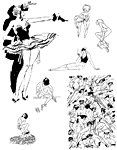 |
 |
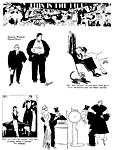 |
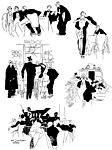 |
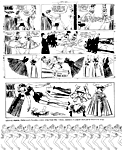 |
Footnit: An
earlier version of this essay appeared in Comic Book Marketplace, No. 97,
December 2002.

send e-mail to R.C. Harvey
art of the comic book - art of the funnies - reviews - order form - rants & raves - Harv's Hindsights - return to main page